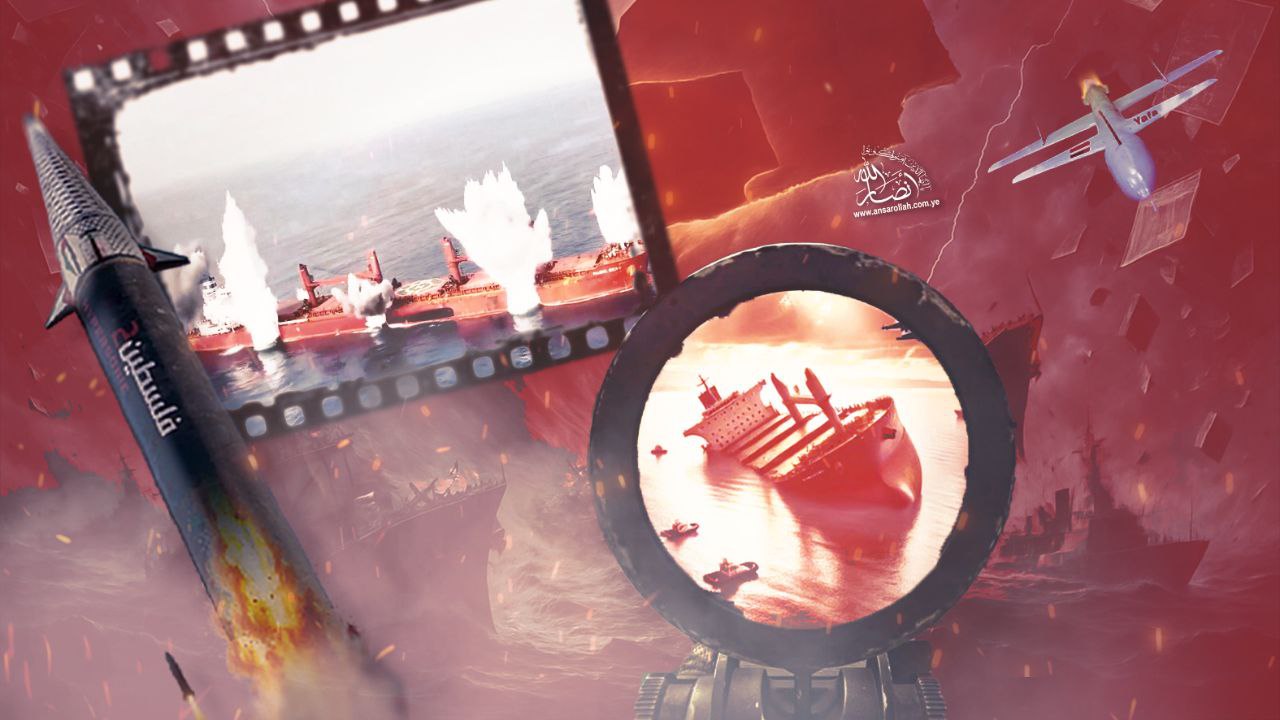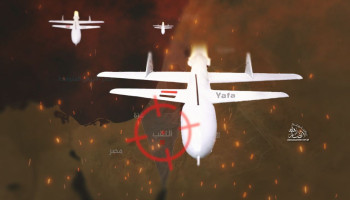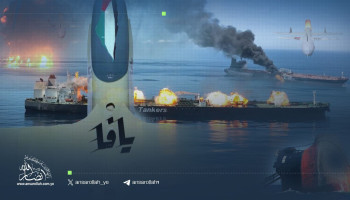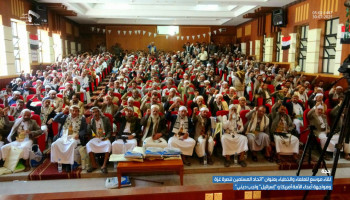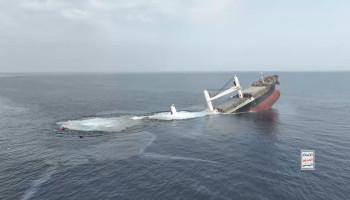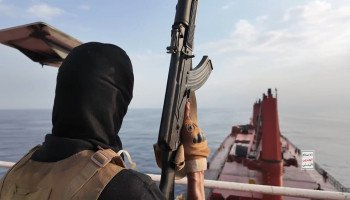In light of the rapid developments in the occupied Palestinian territories—particularly in the Gaza Strip—where the genocidal war continues unabated and thousands of our Palestinian brothers and sisters have been martyred as a result of ongoing aggression and months-long siege, and in the face of a disgraceful silence from the Arab, Islamic, and international communities, Yemen finds itself compelled—before Allah, and out of moral, religious, and humanitarian duty—to stand with the oppressed, who are being subjected daily, and around the clock, to killing and destruction by air, land, and sea bombardment, as well as by starvation and thirst. Such atrocities are unacceptable to any human conscience.
From this standpoint, the Yemeni Armed Forces—relying upon Allah Almighty—have decided to escalate their supportive military operations and to initiate the fourth phase of the naval blockade against the Israeli enemy. This phase includes targeting all vessels belonging to any company that engages with Israeli ports, regardless of the company's nationality or the location where it operates—so long as it falls within the reach of the Yemeni Armed Forces.
The Yemeni Armed Forces' latest announcement marks the launch of a fourth phase in the naval blockade against the Zionist enemy — a deliberate and strategic escalation aimed at tightening the grip on the criminal entity.
This move is expected to intensify economic pressure and push the Zionists into an unprecedented state of maritime isolation, echoing the global air embargo already imposed on them.
By declaring all vessels — of any nationality — as legitimate targets, the Yemeni forces have effectively placed even American ships within their scope.
This represents a serious challenge to the United States, particularly given Yemen's readiness to strike across a wide geography — from the Red Sea and Arabian Sea to the Indian Ocean and the Mediterranean. Crucially, Yemen has both the will and the capability to act on its threats.
One of the immediate consequences of this decision is the sudden tightening of the siege on Haifa Port — a development that may soon escalate to include missile or drone attacks on Ashdod. This would leave the Zionist enemy facing mounting logistical and strategic obstacles.
The expansion of the targeting scope will inevitably raise maritime insurance costs and disrupt the operations of international firms connected to the Zionist entity. The resulting economic strain will be difficult to contain, further deepening the crisis Tel Aviv is already grappling with.
Today, the enemy finds itself in a state of embarrassment and disarray, particularly in light of its failure to deter Sana’a — despite relentless airstrikes on various Yemeni provinces.
Implications of Normalization States’ Support for the Zionist Enemy
Observers note that the Yemeni Armed Forces’ announcement also targets normalization states that cooperate with the Zionist enemy, whether Turkey or any other country — with no exceptions, whether “Islamic” or otherwise. This is underscored by the recent release of interviews by the Yemeni military media with the crew of the ship ETERNITY C, which the Yemeni Armed Forces sank in the Red Sea.
Notably, the crew admitted that the ship’s route was from Berbera Port in Somalia to the port of Umm Rashrash (Eilat), with a stop at the Saudi port of Jeddah for disguise and resupply purposes.
The targeting of this vessel serves as a prelude to operations against companies affiliated with normalization states, signaling that the situation has reached a point of no return.
In his recent speeches, Sayyed Abdul-Malik Badruddin al-Houthi highlighted that certain Arab and Islamic states claim to support Palestine while simultaneously supplying the Israeli enemy with vital provisions. He urged these states to boycott Israel as the least they could do if they retained any shred of morality, values, or Islamic principles.
The Yemeni Armed Forces also revealed that ETERNITY C is operated by COSMO SHIPMANAGEMENT SA, a company managing several vessels that have frequented Zionist ports. Among these are the ship HSL NIKE, which made four voyages from Turkish and Egyptian ports to occupied Haifa during March, April, June, and July of this year, and the ship FAITH, which made two similar voyages in recent months.
The Armed Forces emphasized that the fourth phase of their naval operations will expose the supporters of the Zionist enemy, pointing to an ongoing commercial partnership between Arab and Islamic normalization states and the Zionist enemy — a partnership that underpins its crimes against the Palestinian people.
Expansion of Yemen’s Naval Target Bank
The Yemeni Armed Forces have declared that their fourth-phase operations are not limited to any specific geographic area. They stated that "any place" reached by Yemeni weaponry could become a target, including the Mediterranean Sea, the Cape of Good Hope, and the Indian Ocean. This indicates that Yemen is well-equipped to respond to evolving situations, especially as vessels from the U.S., Europe, and normalization states continue to engage with the Zionist entity. The upcoming phase is expected to involve numerous targeted operations against ships violating Yemen’s directives.
The main goal is to pressure the international community to stop the humanitarian massacre in Gaza. Otherwise, Yemen will persist in enforcing its blockade on the entity and multinational companies supporting it.
By expanding its naval target bank, Yemen aims to further tighten the noose around the Zionist enemy. This move will bring significant political and economic repercussions regionally and globally unless the aggression and siege on Gaza end.
This escalation will directly impact global supply chains, energy and food prices, insurance costs, and shipping fees, putting enormous pressure on countries whose companies support the Zionist entity and navigation to the occupied Palestinian ports. Furthermore, ongoing global crises—such as energy shortages, food insecurity, and economic slowdown—are expected to worsen, creating additional challenges worldwide, especially for nations that manage global shipping markets.
Yemen’s Tactical Weapons
By the grace of God and the dedication of its loyal fighters, Yemen has innovated weapons that deliver significant impact at minimal cost. For the first time, Yemen integrated drones and ballistic missiles into naval warfare, enabling strategic strikes against U.S. military technology. This forced major U.S. fleets to withdraw from the Red Sea conflict zones amid a noticeable collapse in U.S. naval morale.
Official U.S. sources, including the commander of the Fifth Fleet, acknowledged the difficulties faced by U.S. naval forces, admitting that Yemeni tactics and weapons evolve with every strike. Notably, the Yemeni missile’s speed leaves enemy defenses only about 30 seconds to respond — a daunting challenge.
While a Yemeni drone costs a fraction of a U.S. interceptor missile (which can reach $4 million), these drones have compelled the world’s most powerful navy to retreat. This shift marks a new reality in naval engagements: superiority no longer depends solely on quantity, but on the quality and tactical use of available tools.
Yemen’s tactics in the Red Sea focus on exhausting the enemy with low-cost weapons against the high expenses Washington bears in defense. The Yemeni military adeptly combines drones, ballistic, and cruise missiles simultaneously, striking with precise timing.
This approach’s impact was evident when the U.S. Navy lost two advanced F-18 jets and an aircraft carrier had to execute a sudden evasive maneuver to avoid Yemeni missiles — exposing it vulnerably to Yemeni firepower.
The Fourth Phase and the Changing Deterrence Dynamics in the Red Sea
The Yemeni Armed Forces are engaged in a multifaceted conflict that extends beyond direct attacks such as sinking ships and striking targets within the Zionist entity. Their objective is to challenge the longstanding Western dominance over critical maritime routes in the Arab world, particularly the Bab al-Mandeb Strait.
The escalation began in January 2024, when the U.S. Navy attacked three Yemeni naval vessels, resulting in the deaths of 10 Yemeni fighters. This incident led to the declaration of the “Promised Victory and Sacred Jihad” campaign. Since then, U.S. military assets have been targeted by Yemen, prompting Washington to form the “Prosperity Coalition,” an international alliance aimed at neutralizing Yemeni military capabilities and securing the Red Sea coastline. Despite these efforts, the coalition’s operations failed to contain Yemen, culminating in an agreement announced by former U.S. President Donald Trump to halt hostilities against Yemen in exchange for a cessation of attacks on U.S. ships—excluding those connected to the Israeli enemy.
A significant shift in the conflict is Yemen’s ability to directly target four U.S. aircraft carriers, which are central to American naval deterrence and regional control. This development has compelled the U.S. to reconsider its naval strategy in the area.
During a Senate hearing covered by Business Insider, Admiral Daryl Caudle, appointed to lead U.S. naval operations, acknowledged critical vulnerabilities in U.S. naval forces exposed by Yemeni tactics. Yemen effectively utilizes low-cost drones and ballistic missiles to impose a high operational and financial burden on U.S. forces. While a Yemeni drone costs only a few thousand dollars, the U.S. employs interceptor missiles such as the SM-2 and SM-6, which cost up to $4 million each, and occasionally the more expensive SM-3 missiles, priced between $10 and $30 million per unit, to counter these threats.
This pronounced disparity in cost, coupled with ongoing Yemeni assaults on multiple fronts, imposes a considerable strain on U.S. military resources and significantly alters the balance of power in the Red Sea region.
Yemen’s adoption of what U.S. military analysts term the “hell saturation” tactic — launching coordinated waves of drones and missiles against warships — has exposed critical vulnerabilities in advanced defense systems. Unable to intercept all threats simultaneously, even U.S. aircraft carriers have, in the words of one analyst, been reduced to “sitting ducks.”
These tactical gains have sparked serious debate in Washington over the future of traditional naval assets. Within defense circles, there is growing skepticism about the sustainability of investing in expensive platforms like carriers and deterrent submarines, with increasing interest in lower-cost, high-efficiency alternatives such as unmanned boats, drones, and autonomous subs.
During a Senate hearing, Admiral Daryl Caudle acknowledged that the issue is no longer one of intent but of capacity — a clear admission that the U.S. military-industrial complex is struggling to keep up with the demands of modern warfare. This comes as rivals like China and Russia invest heavily in agile, cost-effective military technologies.
A member of the U.S. Senate put it bluntly: “Will our adversaries wait a decade for us to catch up?” — a question that underscores the strategic anxiety now gripping American leadership.
The Red Sea, once a bastion of American naval dominance secured by the Fifth Fleet and coastal bases, is no longer uncontested. The gradual withdrawal of U.S. forces under sustained Yemeni pressure marks not a strategic repositioning, but a forced retreat.
When the U.S. Deputy Secretary of Defense publicly declared that “the era of absolute naval supremacy is over,” it was more than a rhetorical shift. It was an implicit admission that Washington’s grip over critical maritime zones — starting with the Red Sea — is slipping under the weight of asymmetric warfare and a new, unrelenting balance of power.

